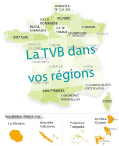A tool that combines biodiversity conservation and land-use planning
Green and blue infrastructure, an ecological network for biodiversity conservation
A strong commitment from the French Ministry of the Environment, green and blue infrastructure (TVB for "Trame verte et bleue") is a biodiversity conservation tool whose purpose is to incorporate the issues of maintaining and strengthening the functionality of natural environments into planning tools and development projects.
In this way it aims to slow down the degradation of biodiversity resulting from land take and habitat fragmentation, in particular by preserving and enhancing ecological continuities, so that populations of plant and animal species can move around and complete their life cycle (diet, reproduction, rest, etc.) under favourable conditions.
French green and blue infrastructure interacts with all the other environmental policies (protected areas, Natura 2000, regional natural parks, national action plans for endangered species, Good Environmental Status (GES) objectives for water bodies, impact studies, etc.), particularly in the context of the french National Biodiversity Strategy 2011-2020. In addition to policies based on knowledge and protection of remarkable species and habitats, green and blue infrastructure also takes the ecological function of habitats and species into account in land-use planning, on the basis of ordinary biodiversity in particular.
A land-use planning too
Accounting for the ecological continuities identified by the regional plans for ecological coherence (SRCE) at a local level – including through urban planning documents produced by public authorities and the use of contractual tools – helps incorporate biodiversity issues into territorial projects. While green and blue infrastructure has primarily environmental objectives, it also contributes to achieving social and economic objectives by maintaining the services provided by biodiversity (e.g. wood energy production, pollination, benefits for agriculture, improvement of water quality, flood regulation, etc.), by enhancing the landscape and cultural value of its spaces (e.g. improving the living environment, hosting recreational activities, etc.), but also through human interventions carried out within the territory (territorial engineering, development, management and maintenance of natural habitats, etc.).





